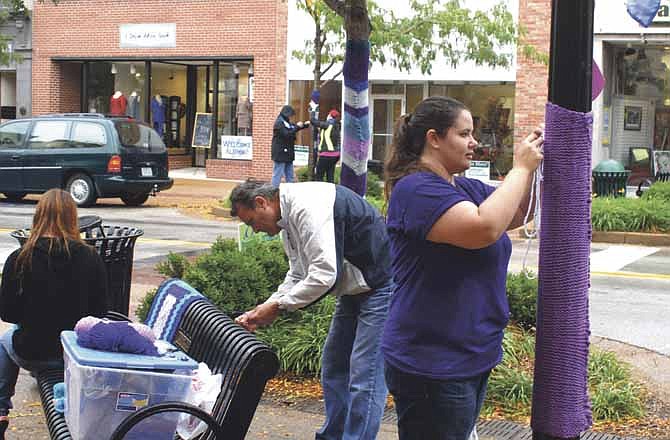Jefferson City, you've been yarn bombed. What, pray tell, is yarn bombing?
It's what happens when a crowd of artistically inclined individuals wrap up a cityscape in colorful shades of string.
On Saturday, volunteers from the Rape and Abuse Crisis Service didn't let a little rain wash away their plan to wrap High Street in enough colorful art to draw attention to the problem of domestic violence.
Also known as "guerilla knitting" or "yarn storming," the phenomenon is believed to have first started in Texas around 2005 when knitters in the Lone Star state looked for creative ways to repurpose their unfinished knitting projects. (Trees are frequent targets.)
"This is a first-time project for us," said Pam Otto, RACS volunteer and outreach coordinator. "Although one in four women will experience domestic violence in her lifetime, most people are still uncomfortable talking about it. That's where Domestic Violence Awareness Month comes in."
The project was the brainchild of Katryn Douglas, a 27-year-old fine arts student at Washington University.
Douglas originally approached some St. Louis organizations with her idea, but they didn't have enough volunteers to pull a project off. Douglas was able to reach out to RACS through her mother, who works in Jefferson City.
"They (RACS) were so excited and they jumped right on board," she said.
Although Douglas was "raised in a home where respect was so important," she has empathy for others who live in fear.
She said she only recently realized many of her female friends, family members and acquaintances have coped with domestic violence. She said victims often feel ashamed of what happened.
Otto added by raising awareness, advocates can create a safer atmosphere that allows victims to more easily come forward and raises the level of accountability for perpetrators.
Otto said volunteers knitted and crocheted several scarf-like garments to be wrapped around the trunks of the Capital City's graceful locust trees. Downtown visitors also will see some of the downtown's benches wrapped in colorful cozies. In addition, Otto expected Hawthorn Bank's metal railing to serve as an arty place to share the group's anti-violence message of "End Abuse" and "Respect Respect."
Mainly four colors of yarn - purple to represent domestic violence, teal for sexual assault, silver for stalking and blue for child abuse - will be used to raise awareness for these real-world problems.
People who want to learn more about domestic violence prevention and response will be able to scan QR, or quick-response, codes with their smartphones or visit the National Coalition for Domestic Violence's website.
People who want to contact RACS can do so by calling that organization's hotline at 800-303-0013 or 573-634-4911.
Volunteers started the project on Saturday and will finish their work today. The art installation is expected to stay for one month.
Otto said: "We think it's going to garner attention when people say, "What in the world is that?'"
Accompanying photo: Volunteers decorate downtown in yarn
What is domestic violence?
Domestic violence is the willful intimidation, physical assault, battery, sexual assault or any other abusive behavior perpetrated by an intimate partner against another. Often accompanied by emotionally abusive and controlling behavior, it affects people from all walks of life. It can result in physical injury, psychological trauma and sometimes death. The consequences can last a lifetime.
Domestic violence facts
• More than 1,870 incidents of domestic violence were reported in the Rape and Abuse Crisis Service area in 2012.
• Statistically, between one in five to one in seven incidents are actually reported.
• Sixteen cases of forcible or attempted rape were reported in 2012, up from seven in 2010.
• The number of reported incidents of domestic violence in Cole County in 2012 ranks the county 14th of 114 in having the most reports, according to the Missouri Crime Reporting Supplemental Domestic Violence Incident Report.
• RACS sheltered 226 people in 2012. The service also provided counseling to 600 to 700 individuals and handled 1,100 hotline calls from around Mid-Missouri in 2012.
• An estimated 1.3 million American women are victims of physical assault by an intimate partner each year.
• 85 percent of domestic violence victims are women.
• Females age 20-24 years old are at the greatest risk of non-fatal intimate partner violence.
• Witnessing violence between a person's parents or caretakers is the strongest risk-factor for transmitting violent behavior to the next generation.
• Between 30 and 60 percent of perpetrators also abuse children in the household.
Sources: RACS, National Coalition Against Domestic Violence

